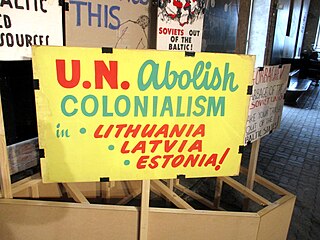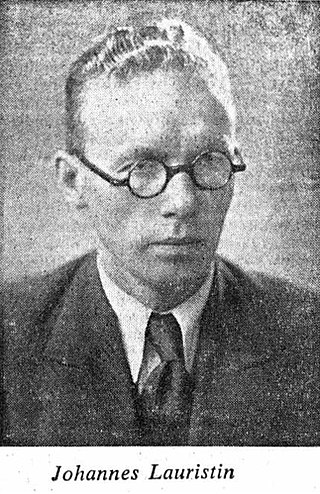
The three independent Baltic countries – Estonia, Latvia, and Lithuania – were invaded and occupied in June 1940 by the Soviet Union, under the leadership of Stalin and auspices of the Molotov–Ribbentrop Pact that had been signed between Nazi Germany and the Soviet Union in August 1939, immediately before the outbreak of World War II. The three countries were then annexed into the Soviet Union in August 1940. The United States and most other Western countries never recognised this incorporation, considering it illegal. On 22 June 1941, Nazi Germany attacked the Soviet Union and within weeks occupied the Baltic territories. In July 1941, the Third Reich incorporated the Baltic territory into its Reichskommissariat Ostland. As a result of the Red Army's Baltic Offensive of 1944, the Soviet Union recaptured most of the Baltic states and trapped the remaining German forces in the Courland Pocket until their formal surrender in May 1945.

The Riigikogu is the unicameral parliament of Estonia. In addition to approving legislation, the Parliament appoints high officials, including the prime minister and chief justice of the Supreme Court, and elects the president. Among its other tasks, the Riigikogu also ratifies significant foreign treaties that impose military and proprietary obligations and bring about changes in law, as well as approves the budget presented by the government as law, and monitors the executive power.

Johannes Vares was an Estonian and Soviet poet, medical doctor, and politician.
The Estonian Sovereignty Declaration, fully: Declaration on the Sovereignty of the Estonian SSR, was issued on November 16, 1988 during the Singing Revolution in the Estonian SSR. The declaration asserted Estonia's sovereignty and the supremacy of the Estonian laws over the laws of the Soviet Union. Estonia's parliament also laid claim to the republic's natural resources: land, inland waters, forests, mineral deposits and to the means of industrial production, agriculture, construction, state banks, transportation, municipal services, etc. in the territory of Estonia's borders. November 16 is now celebrated annually as the "Day of Declaration of Sovereignty".

The Estonian Soviet Socialist Republic, also known as the Estonian SSR, Soviet Estonia, or simply Estonia, was a union republic and an ethnically based administrative subdivision of the former Soviet Union (USSR) covering the occupied and annexed territory of Estonia in 1940–1941 and 1944–1991. The Estonian SSR was nominally established to replace the until then independent Republic of Estonia on 21 July 1940, a month after the 16–17 June 1940 Soviet military invasion and occupation of the country during World War II. After the installation of a Stalinist government which, backed by the occupying Soviet Red Army, declared Estonia a Soviet constituency, the Estonian SSR was subsequently incorporated into the Soviet Union as a "union republic" on 6 August 1940. Estonia was occupied by Nazi Germany in 1941, and administered as a part of Reichskommissariat Ostland until it was reconquered by the USSR in 1944.
Elections to the Supreme Soviet of the Estonian SSR were held on 16 February 1947. They were the first elections since the Estonian SSR was declared on 21 July 1940 and the first after World War II.
Elections to the Supreme Soviet of the Estonian SSR were held on 25 February 1951. The Bloc of Communists and Non-Party Candidates was the only party able to contest the elections, and won all 115 seats. Elected members included Joseph Stalin, Vyacheslav Molotov, Georgi Malenkov and Panteleimon Ponomarenko.
Elections to the Supreme Soviet of the Estonian SSR were held on 27 February 1955. The Bloc of Communists and Non-Party Candidates was the only party able to contest the elections, and won all 125 seats.
Elections to the Supreme Soviet of the Estonian SSR were held on 15 March 1959. The Bloc of Communists and Non-Party Candidates was the only party able to contest the elections, and won all 125 seats.
Elections to the Supreme Soviet of the Estonian SSR were held on 17 March 1963. The Bloc of Communists and Non-Party Candidates was the only party able to contest the elections, and won all 178 seats.
Elections to the Supreme Soviet of the Estonian SSR were held on 19 March 1967. The Bloc of Communists and Non-Party Candidates was the only party able to contest the elections, and won all 178 seats.
Elections to the Supreme Soviet of the Estonian SSR were held on 13 June 1971. The Bloc of Communists and Non-Party Candidates was the only party able to contest the elections, and won all 183 seats.
Elections to the Supreme Soviet of the Estonian SSR were held on 15 June 1975. The Bloc of Communists and Non-Party Candidates was the only party able to contest the elections, and won all 200 seats.
Elections to the Supreme Soviet of the Estonian SSR were held on 24 February 1980. The Bloc of Communists and Non-Party Candidates was the only party able to contest the elections, and won all 285 seats.
Elections to the Supreme Soviet of the Estonian SSR were held on 24 February 1985. The Bloc of Communists and Non-Partisans was the only party able to contest the elections, and won all 285 seats.
Estonian Restoration of Independence, legally defined as the Restoration of the Republic of Estonia, was proclaimed on 20 August 1991. On that day at 23:02 local time, the Supreme Council of the Republic of Estonia, in agreement with the Estonian Committee, declared the illegal Soviet occupation and annexation of the country terminated, and proclaimed the full restoration of the independence of Estonia.

Johannes Lauristin was an Estonian communist politician, activist, writer and statesman who served as the first Chairman of the Council of People's Commissars of the Estonian Soviet Socialist Republic. Hs wife was communist politician Olga Lauristin and his daughter was politician Marju Lauristin.